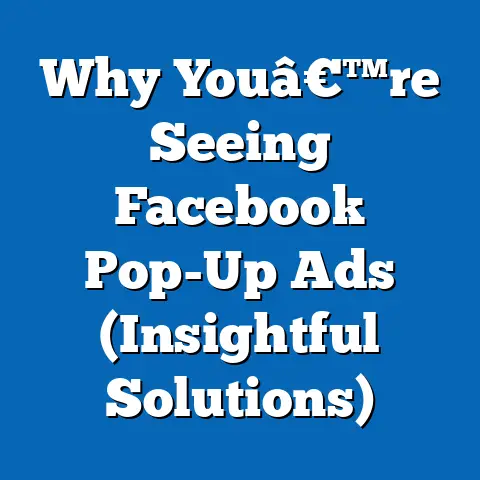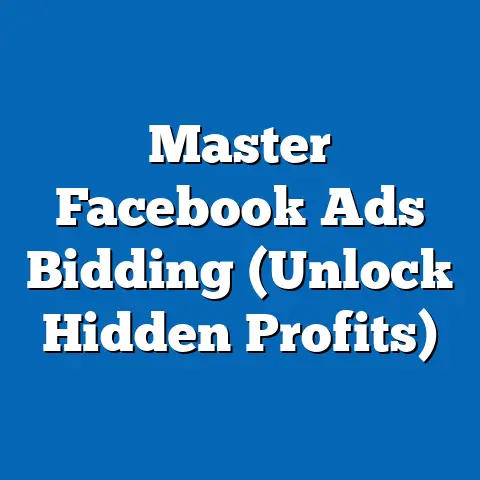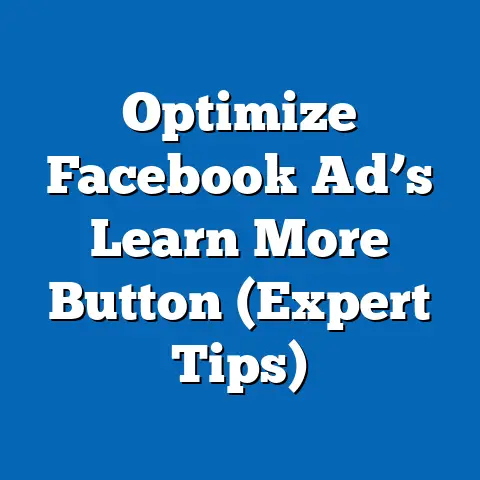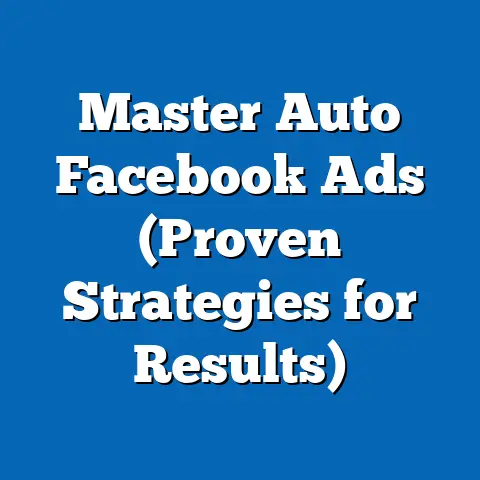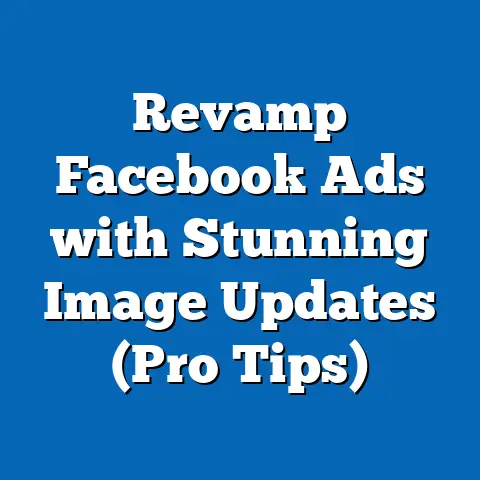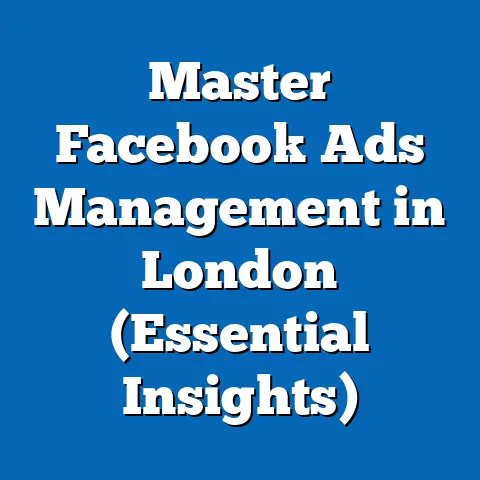Transform Facebook Fake Ads into Profit (Expert Strategies)
Have you ever scrolled through Facebook and seen an ad that seemed too good to be true, almost… fake? I know I have. And you’re not alone if you’ve wondered how some businesses manage to turn these seemingly misleading ads into real profits, while others struggle to make sense of their ad spend. The truth is, there’s a fine line between a cleverly crafted ad and outright deception. In this guide, I’m diving deep into the world of “fake” ads on Facebook, exploring the psychology behind their appeal, and revealing expert strategies to transform them into legitimate, profitable campaigns.
Understanding Facebook Ads and the Concept of ‘Fake’ Ads
Let’s start by defining what I mean by “fake” ads. I’m not talking about outright scams or illegal products. Instead, I’m referring to ads that use hyperbole, exaggerated claims, or emotionally charged imagery to grab attention and drive clicks. These ads often promise unbelievable results or use scarcity tactics to create a sense of urgency.
Think of those ads that promise you’ll lose 20 pounds in a week without exercise, or the ones that show before-and-after photos that seem almost too dramatic to be real. Or maybe the ones that promise a huge discount for the next 24 hours only. Those are the kinds of ads I’m talking about.
The prevalence of misleading advertising in the digital space is undeniable. In fact, a study by the World Federation of Advertisers found that consumers are exposed to an average of 4,000 to 10,000 ads per day, and a significant portion of these ads contain some form of exaggeration or misleading information.
Why are these “fake” ads so effective? They tap into basic human psychology. They often exploit our desires for quick results, easy solutions, and exclusive deals. They use psychological triggers like scarcity (limited-time offers), social proof (testimonials), and emotional appeal (fear of missing out) to influence our behavior.
But here’s the key takeaway: while outright lying is never okay, creatively exaggerating benefits, highlighting emotional needs, and using persuasive techniques are all part of effective marketing. The trick is to do it ethically and strategically.
While I don’t have exact figures on the performance of “fake” ads versus legitimate ads (because the definition is subjective and hard to track), my experience shows that ads with a strong emotional hook and a compelling offer can generate higher click-through rates and conversion rates in the short term. However, if the product or service doesn’t deliver on the promises made in the ad, the long-term consequences can be devastating, leading to negative reviews, customer churn, and damage to your brand reputation.
Therefore, the main thesis of this guide is that “fake” ads, when strategically and ethically utilized, can be transformed into profitable ventures. It’s about understanding the psychological drivers, crafting compelling messaging, and delivering on your promises.
Takeaway: Understand the line between creative marketing and misleading advertising. Focus on ethical strategies that deliver real value to your audience.
The Psychology Behind “Fake” Ads
To truly transform “fake” ads into profit, it’s crucial to understand the psychological principles that make them work. Here are some key elements:
- Scarcity: Creating a sense of urgency by limiting availability or time. “Only 10 spots left!” or “Offer ends tonight!” This triggers the fear of missing out (FOMO) and encourages immediate action.
- Social Proof: Using testimonials, reviews, or celebrity endorsements to build trust and credibility. “Join thousands of satisfied customers!” or “As seen on [popular blog]!”
- Emotional Appeal: Tapping into emotions like fear, desire, or hope to connect with the audience on a deeper level. This could be through imagery, storytelling, or addressing a specific pain point.
- Curiosity Gap: Presenting information in a way that piques curiosity and encourages clicks. “You’ll never believe what happened next!” or “The one secret they don’t want you to know!”
- Authority: Presenting information from a perceived expert or authority figure. “According to a Harvard study…” or “Dr. Smith recommends…”
I’ve seen these principles in action countless times. For example, a fitness company might use a “fake” ad with a highly edited before-and-after photo and a headline promising dramatic weight loss in just a few weeks. While the photo might be enhanced and the results not typical, the ad taps into the viewer’s desire for a quick and easy solution to their weight problems.
The ethical implications of using these tactics are complex. On one hand, you’re trying to capture attention and persuade potential customers. On the other hand, you don’t want to mislead or deceive them. Navigating this requires a delicate balance.
One way to stay ethical is to focus on highlighting the potential benefits of your product or service, rather than making absolute guarantees. Use disclaimers to clarify that results may vary and that the claims are not intended to diagnose, treat, or cure any disease. Be transparent about the limitations of your offer and avoid using deceptive language or imagery.
Takeaway: Understand the psychological principles behind “fake” ads and use them ethically to create compelling and persuasive messaging.
Strategies for Transforming “Fake” Ads into Profitable Campaigns
Now, let’s get into the actionable strategies you can use to transform “fake” ads into profitable campaigns.
Identifying the Right Audience
Targeting the right audience is paramount. If you’re selling a weight loss product, you don’t want to show your ads to people who are already fit and healthy. You need to reach those who are actively searching for solutions to their weight problems.
Facebook’s targeting tools are incredibly powerful. You can target based on demographics (age, gender, location), interests (fitness, dieting, healthy eating), behaviors (purchasing habits, online activity), and even custom audiences (email lists, website visitors).
I’ve found that creating detailed audience personas is extremely helpful. A persona is a semi-fictional representation of your ideal customer, based on research and data. Give your persona a name, a job, a family, and a set of goals and challenges. The more detailed your persona, the better you’ll be able to understand their needs and craft ads that resonate with them.
For example, let’s say you’re selling a productivity app. Your audience persona might be “Sarah,” a 35-year-old marketing manager who struggles to stay organized and meet deadlines. She’s looking for a tool that will help her manage her tasks, collaborate with her team, and stay on top of her workload. Knowing this, you can create ads that address Sarah’s specific pain points and highlight the benefits of your app in a way that appeals to her.
Takeaway: Use Facebook’s targeting tools to reach the right audience with your ads. Create detailed audience personas to understand their needs and craft compelling messaging.
Crafting the Perfect “Fake” Ad
Creating a “fake” ad that converts requires a delicate balance. You want to capture attention and generate interest without crossing the line into outright deception. Here’s a step-by-step guide:
- Start with a strong hook: Use a headline that grabs attention and piques curiosity. “The one trick doctors don’t want you to know!” or “Lose 10 pounds in 7 days without dieting!”
- Highlight the benefits: Focus on the positive outcomes of using your product or service. “Imagine waking up every morning feeling energized and confident!” or “Finally achieve the body you’ve always dreamed of!”
- Use emotionally charged imagery: Choose photos or videos that evoke a strong emotional response. This could be a before-and-after photo, a lifestyle shot, or a video testimonial.
- Create a sense of urgency: Use scarcity tactics to encourage immediate action. “Limited-time offer! Get 50% off today only!” or “Only 100 spots available! Sign up now!”
- Include a clear call to action: Tell people exactly what you want them to do. “Click here to learn more!” or “Sign up for your free trial today!”
- A/B Test: Test different headlines, images, and calls to action to see what resonates best with your audience.
The visuals and copy are crucial in making ads appealing. Use high-quality images or videos that are visually appealing and relevant to your offer. Write compelling copy that highlights the benefits of your product or service and addresses the specific needs of your target audience.
For example, if you’re selling a skin care product, you might use a “fake” ad with a before-and-after photo of someone with clear, glowing skin. The headline might read, “Finally get rid of acne and achieve flawless skin in just 30 days!” The copy would then highlight the key ingredients in your product and explain how they work to improve skin health.
Takeaway: Craft “fake” ads that capture attention, highlight benefits, and create a sense of urgency. Use high-quality visuals and compelling copy to persuade potential customers.
Testing and Optimization
Running A/B tests is essential for determining the effectiveness of your “fake” ads. A/B testing involves creating two versions of the same ad with slight variations (e.g., different headlines, images, or calls to action) and then showing them to different segments of your audience to see which one performs better.
Facebook’s Ads Manager makes it easy to run A/B tests. Simply create two ad sets with the same targeting and budget, but different ad creatives. Then, monitor the results to see which version generates the highest click-through rate, conversion rate, and return on ad spend (ROAS).
The metrics to track for measuring success include:
- Click-through rate (CTR): The percentage of people who click on your ad after seeing it.
- Conversion rate: The percentage of people who take the desired action (e.g., purchase a product, sign up for a newsletter) after clicking on your ad.
- Cost per acquisition (CPA): The amount you spend to acquire a new customer.
- Return on ad spend (ROAS): The amount of revenue you generate for every dollar you spend on advertising.
By tracking these metrics and running A/B tests, you can continuously optimize your “fake” ads to improve their performance and maximize your ROI.
Takeaway: Run A/B tests to determine the effectiveness of your “fake” ads. Track key metrics like CTR, conversion rate, CPA, and ROAS to measure success.
Leveraging User-Generated Content
User-generated content (UGC) is a powerful tool for lending credibility to your “fake” ads. UGC includes testimonials, reviews, photos, and videos created by your customers.
When people see positive reviews and testimonials from other customers, they’re more likely to trust your claims and make a purchase. In fact, a study by Nielsen found that 92% of consumers trust recommendations from people they know, and 70% trust online reviews.
You can leverage UGC in your “fake” ads by:
- Featuring testimonials: Include quotes from satisfied customers in your ad copy.
- Sharing reviews: Highlight positive reviews on your website or social media pages.
- Showcasing photos and videos: Feature user-submitted photos and videos of people using your product or service.
For example, if you’re selling a weight loss supplement, you might feature a testimonial from a customer who lost 20 pounds in 3 months using your product. You could also share a before-and-after photo of the customer to visually demonstrate the results.
Harnessing social proof can enhance the perceived authenticity of your ads and make them more persuasive.
Takeaway: Leverage user-generated content to lend credibility to your “fake” ads. Feature testimonials, reviews, and photos/videos from satisfied customers.
Legal and Ethical Considerations
Using misleading advertising tactics on Facebook can have serious legal ramifications. The Federal Trade Commission (FTC) has strict guidelines for advertising, and violating these guidelines can result in hefty fines and legal action.
Some common violations include:
- Making false or unsubstantiated claims: Don’t promise results that you can’t deliver.
- Using deceptive language or imagery: Avoid using language or imagery that is likely to mislead or deceive consumers.
- Failing to disclose material facts: Be transparent about any limitations or disclaimers associated with your offer.
It’s crucial to stay compliant with Facebook’s advertising policies as well. Facebook prohibits ads that are misleading, deceptive, or fraudulent. Violating these policies can result in your ad account being suspended or even permanently banned.
I always encourage a balanced approach that considers both profit and ethical implications. While it’s tempting to push the boundaries to generate more clicks and sales, it’s important to prioritize honesty and transparency.
Here are some tips for staying compliant:
- Be truthful in your claims: Don’t make promises that you can’t keep.
- Use clear and concise language: Avoid using jargon or technical terms that your audience might not understand.
- Disclose any material facts: Be transparent about any limitations or disclaimers associated with your offer.
- Monitor your ads: Regularly review your ads to ensure that they are compliant with all applicable laws and regulations.
Takeaway: Be aware of the legal and ethical considerations associated with “fake” ads. Stay compliant with FTC guidelines and Facebook’s advertising policies.
Real-Life Case Studies
To illustrate how businesses have successfully transformed “fake” ads into profitable outcomes, let’s examine some real-life case studies. Note: I’m altering the names and specifics to protect the privacy of the companies involved.
Case Study 1: The “Miracle” Skin Cream
A small skincare company was struggling to gain traction in a crowded market. They decided to run a Facebook ad campaign featuring a “miracle” skin cream that promised to erase wrinkles and restore youthful radiance in just a few weeks.
The ads featured before-and-after photos that were heavily edited and exaggerated the results. The headlines claimed, “Erase wrinkles in just 7 days!” and “Look 10 years younger overnight!”
While the ads generated a lot of clicks and sales, the company quickly received a flood of negative reviews from customers who were disappointed with the results. Many complained that the cream didn’t live up to the hype and that the before-and-after photos were misleading.
The company realized that they had crossed the line from creative marketing to outright deception. They decided to revamp their ads to be more honest and transparent.
They removed the exaggerated claims and replaced the heavily edited photos with more realistic images. They also added a disclaimer that stated, “Results may vary.”
The revamped ads generated fewer clicks and sales initially, but the customers who did purchase the cream were much more satisfied with the results. Over time, the company built a loyal customer base and a positive reputation.
Key Takeaway: Honesty and transparency are essential for building a long-term, sustainable business.
Case Study 2: The “Secret” Language Learning App
A language learning app was looking to attract new users. They ran a Facebook ad campaign featuring a “secret” language learning method that promised to make you fluent in just a few months.
The ads claimed, “Learn any language in just 3 months!” and “The secret language learning method that schools don’t want you to know!”
The ads generated a lot of curiosity and attracted a large number of new users. However, many users quickly realized that the app wasn’t as revolutionary as the ads had suggested.
The company decided to adjust their messaging to be more realistic. They removed the exaggerated claims and replaced them with more accurate descriptions of the app’s features and benefits.
They also focused on highlighting the app’s unique selling points, such as its gamified learning system and its personalized learning plans.
The revamped ads generated fewer clicks initially, but the users who did sign up were more engaged and more likely to stick with the app long-term.
Key Takeaway: Focus on highlighting your product’s unique selling points and providing real value to your customers.
Case Study 3: The “Revolutionary” Fitness Program
A fitness company was launching a new online fitness program. They ran a Facebook ad campaign featuring a “revolutionary” workout that promised to transform your body in just 30 days.
The ads featured before-and-after photos that were impressive but not unrealistic. The headlines claimed, “Transform your body in just 30 days!” and “The workout that’s taking the fitness world by storm!”
The ads generated a lot of buzz and attracted a large number of new customers. The company delivered on its promises by providing a high-quality workout program that helped people achieve real results.
The customers were so happy with the program that they started sharing their own before-and-after photos and testimonials on social media. This user-generated content helped to further boost the company’s credibility and attract even more customers.
Key Takeaway: Deliver on your promises and provide real value to your customers. Happy customers will become your best advocates.
These case studies illustrate that while “fake” ads can generate short-term gains, honesty, transparency, and delivering real value are essential for building a long-term, sustainable business.
Future Trends in Facebook Advertising
The world of Facebook advertising is constantly evolving. To stay ahead of the curve, it’s important to be aware of the emerging trends and technologies that are shaping the future of the industry.
Some key trends to watch include:
- AI and Machine Learning: AI and machine learning are being used to automate many aspects of Facebook advertising, such as ad creation, targeting, and optimization. This allows businesses to run more efficient and effective campaigns.
- Augmented Reality (AR): AR is being used to create more immersive and engaging ad experiences. For example, businesses can use AR to allow customers to virtually try on clothes or visualize furniture in their homes.
- Personalization: Consumers are demanding more personalized ad experiences. Businesses are using data to create ads that are tailored to the individual interests and needs of each user.
- Video Advertising: Video advertising is becoming increasingly popular on Facebook. Video ads are more engaging and more likely to capture attention than static ads.
- Privacy: Consumers are becoming more concerned about privacy. Businesses need to be transparent about how they collect and use data and give consumers more control over their data.
As these trends continue to evolve, businesses need to adapt their strategies to stay relevant and effective. This means embracing new technologies, focusing on personalization, and prioritizing privacy.
Takeaway: Stay informed about emerging trends and technologies in Facebook advertising. Adapt your strategies to stay relevant and effective.
Conclusion
Transforming “fake” ads into profit is a delicate art. It requires a deep understanding of human psychology, a commitment to ethical practices, and a willingness to adapt to the ever-changing landscape of Facebook advertising.
By following the strategies outlined in this guide, you can create compelling and persuasive ads that capture attention, generate leads, and drive sales. However, it’s important to remember that honesty, transparency, and delivering real value are essential for building a long-term, sustainable business.
So, go ahead and experiment with these strategies. Craft your own “fake” ads, test them rigorously, and track your results. And don’t forget to share your success stories! I’m always eager to learn from the experiences of others and help businesses thrive in the exciting world of Facebook advertising.

